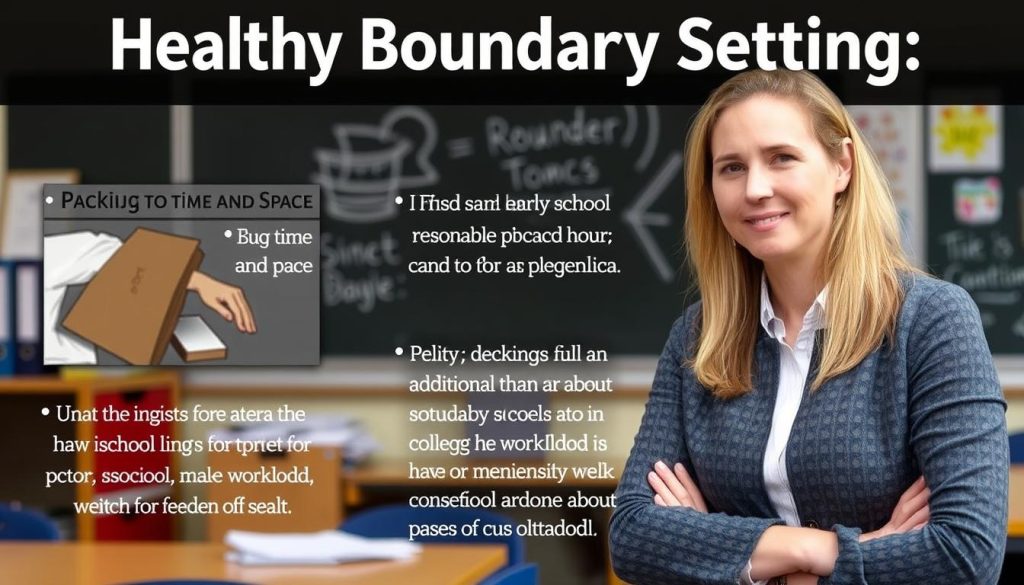Taking even brief moments for self-care during the school day can significantly reduce stress levels
Why Every Teacher Needs a Guide to Self-Care
According to a survey by the American Federation of Teachers, 61% of teachers report that their work is always or often stressful—significantly higher than other professions. This chronic stress doesn’t just affect you; it impacts your students and the entire educational environment.
Self-care isn’t about occasional indulgence—it’s about creating sustainable practices that help you thrive personally and professionally. When you prioritize your wellbeing, you’re better equipped to handle classroom challenges, demonstrate patience, and maintain the enthusiasm that makes learning exciting for your students.
“Self-care is not selfish. You cannot serve from an empty vessel.”
Eleanor Brown
As teachers, your professional identity often becomes intertwined with your personal one. This Guide to Self-Care recognizes that reality while providing practical ways to establish boundaries that protect your wellbeing. The teacher skills you’ve developed to support your students—organization, empathy, communication—can be redirected toward your own self-care practice.
Signs You Need More Self-Care
- Feeling exhausted even after a full night’s sleep
- Increased irritability with students or colleagues
- Dreading going to work
- Difficulty concentrating or making decisions
- Physical symptoms like headaches or tension
- Decreased satisfaction from teaching
- Feeling disconnected from students and colleagues
The Six Dimensions of a Complete Guide to Self-Care
Effective self-care addresses multiple aspects of your life. Understanding these dimensions helps you create a balanced approach that truly supports your wellbeing as an educator.

Physical Self-Care
Your body needs attention to function optimally. Physical self-care includes adequate sleep (7-9 hours), nutritious meals, regular movement, and preventative healthcare. For teachers who spend hours standing and speaking, physical wellbeing directly impacts your teacher skills and classroom stamina.
Quick Tip: Keep a water bottle at your desk and set silent reminders to drink throughout the day.
Emotional Self-Care
Teaching involves significant emotional labor. Practices like journaling, talking with supportive friends, or working with a therapist help process the complex feelings that arise. Emotional intelligence is among the most valuable teacher skills—nurture it in yourself first.
Quick Tip: Create a “feelings check-in” habit before and after school to acknowledge your emotional state.
Social Self-Care
Meaningful connections outside the classroom provide perspective and support. Cultivate relationships with people who energize rather than drain you. Fellow educators can offer unique understanding, but diversifying your social circle prevents work from dominating all conversations.
Quick Tip: Schedule one non-school-related social activity each week to maintain balance.
Intellectual Self-Care
Engage your mind outside of teaching responsibilities. Pursue learning that’s purely for pleasure, whether through reading, podcasts, or courses unrelated to education. This intellectual variety enhances creativity and problem-solving teacher skills that benefit your classroom approach.
Quick Tip: Dedicate 15 minutes daily to reading something unrelated to teaching.
Spiritual Self-Care
Connect with what gives your life meaning and purpose. This might involve religious practices, meditation, nature walks, or philosophical reflection. Spiritual grounding helps maintain perspective when facing educational challenges and strengthens your resilience.
Quick Tip: Begin each day with a 3-minute mindfulness practice to center yourself.
Occupational Self-Care
Create boundaries and practices that make teaching sustainable. This includes organizing your workspace, setting realistic grading timelines, and pursuing professional development that genuinely interests you. Enhancing your teacher skills through thoughtful development reduces stress by increasing competence and confidence.
Quick Tip: Identify one task you can streamline or eliminate from your routine.
Enhance Your Teacher Skills Through Professional Development
Investing in your professional growth is a powerful form of self-care. Explore courses designed specifically for K12 teachers that build both competence and confidence in the classroom.
Daily Habits from the Ultimate Guide to Self-Care
Small, consistent actions create the foundation for teacher wellbeing. These practical habits require minimal time but offer significant benefits for your physical and mental health.

Morning Routine (15-30 minutes)
- Wake up 15 minutes earlier than necessary to avoid rushing
- Drink a full glass of water before coffee or tea
- Practice 5 minutes of mindful breathing or gentle stretching
- Write down three priorities for the day (teaching and personal)
- Prepare a nutritious breakfast, even if it’s simple
A deliberate morning routine sets the tone for your entire day. By taking control of your first waking hour, you’re less likely to feel that the day is controlling you. This proactive approach enhances teacher skills like organization and time management that transfer to classroom effectiveness.
Even on the busiest mornings, taking just 5 minutes for yourself can significantly impact your mindset. Consider which elements of this routine would most benefit your specific situation and start with implementing just one or two.
During School Hours
- Microbreaks: Take 30-second breathing pauses between classes or activities
- Hydration: Keep a water bottle at your desk and refill it at least twice
- Lunch mindfully: Step away from your desk, even if just to sit elsewhere for 10 minutes
- Physical reset: Stretch or walk around the classroom when students are working independently
- Emotional check-in: Notice when stress rises and use a quick grounding technique

After School Transition
The transition from school to home is crucial for maintaining work-life boundaries. Create a deliberate “closure ritual” to signal the end of your teaching day:
- Spend 10 minutes organizing your desk for tomorrow
- Write down any unfinished tasks so they don’t occupy mental space
- Change clothes when you get home to physically mark the transition
- Take a 5-minute “decompression pause” before engaging with home responsibilities
- Limit the time you spend checking email or doing school work in the evening
“The ability to transition well between school and home is one of the most underrated teacher skills that directly impacts wellbeing.”
Many teachers struggle with mentally “leaving work at work.” Creating physical rituals helps your brain recognize when teaching time has ended. This boundary-setting is essential for sustainable teaching and prevents the burnout that comes from being perpetually “on duty.”
Evening Routine
- Engage in one activity purely for enjoyment (not school-related)
- Limit screen time in the hour before bed
- Prepare for tomorrow (clothes, lunch, materials) to reduce morning stress
- Practice a brief gratitude reflection, noting one positive moment from the day
- Establish a consistent bedtime that allows for 7-8 hours of sleep
Sleep: The Foundation of Teacher Wellbeing
According to research from the Sleep Foundation, consistent sleep habits significantly improve cognitive function, emotional regulation, and immune system strength—all critical for effective teaching. Prioritizing sleep is one of the most impactful self-care practices for educators.
Teacher Skills Enhanced by Self-Care Practices
Self-care doesn’t just benefit your personal wellbeing—it directly enhances the professional capabilities that make you effective in the classroom. Understanding this connection helps prioritize self-care as an essential component of professional development.

| Self-Care Practice | Teacher Skills Enhanced | Classroom Impact |
| Regular physical activity | Energy management, stress resilience | Sustained enthusiasm throughout the day, quicker recovery from challenging situations |
| Mindfulness meditation | Emotional regulation, present-moment awareness | Reduced reactivity to student behavior, improved ability to notice student needs |
| Adequate sleep | Cognitive function, decision-making | Better instructional choices, more creative problem-solving |
| Social connection | Empathy, communication | Stronger student relationships, more effective parent interactions |
| Boundary setting | Time management, prioritization | More focused lesson planning, sustainable grading practices |
| Reflective practices | Self-awareness, growth mindset | Continuous improvement in teaching methods, modeling lifelong learning |
When you invest in self-care, you’re simultaneously developing teacher skills that make you more effective and resilient in the classroom. This dual benefit makes self-care a professional responsibility rather than a luxury.
Develop Self-Care Teacher Skills Through Specialized Courses
Enhance both your wellbeing and professional capabilities with courses designed specifically for K12 educators. Our professional development opportunities integrate self-care principles with practical classroom strategies.
Mindfulness: A Cornerstone of Any Guide to Self-Care
Mindfulness—the practice of bringing non-judgmental awareness to the present moment—offers particular benefits for teachers. In a profession where you’re constantly responding to others’ needs, mindfulness helps you reconnect with yourself.

Simple Mindfulness Practices for Teachers
1-Minute Practices
- Bell Listening: Ring a small bell (or use a phone app) and focus completely on the sound until it fades entirely
- Three Breaths: Take three deliberate, deep breaths while fully focusing on the sensation
- Hand Warming: Rub your hands together, then focus on the warmth and tingling sensations
5-Minute Practices
- Body Scan: Systematically notice sensations from your feet to your head without judgment
- Mindful Walking: Walk slowly down a hallway, fully aware of each step and breath
- Gratitude Reflection: Identify three specific things you appreciate about your teaching day
According to a study published in the Journal of Occupational Health Psychology, teachers who practiced mindfulness for just 8 weeks reported significant reductions in psychological distress and improvements in classroom organization. These benefits directly enhance teacher skills like classroom management and student engagement.
“Mindfulness isn’t about eliminating stress—it’s about developing a new relationship with it. For teachers, this skill is invaluable both personally and professionally.”
Integrating Mindfulness Into Teaching
Beyond personal practice, mindfulness can become part of your teaching approach, benefiting both you and your students:
- Begin class with a 30-second centering activity to help everyone transition
- Introduce “mindful moments” during transitions between activities
- Model mindful responses to challenging classroom situations
- Incorporate brief breathing exercises before tests or difficult lessons
- Create a designated quiet space in your classroom for mindful breaks
These practices not only support your wellbeing but also teach students valuable self-regulation skills. By modeling mindfulness, you’re demonstrating essential teacher skills while creating a calmer classroom environment.
Building a Support System: A Critical Part of Your Guide to Self-Care
Teaching can sometimes feel isolating, despite being surrounded by people all day. Creating intentional support systems is essential for sustainable wellbeing and professional growth.

Types of Support Every Teacher Needs
Professional Support
- Mentor relationships with experienced educators
- Professional learning communities focused on specific interests
- Administrator support for classroom needs and professional growth
- Cross-grade collaboration to share resources and strategies
Emotional Support
- Trusted colleagues who understand teaching challenges
- Friends outside education who provide perspective
- Family members who respect work boundaries
- Mental health professionals when needed
Practical Support
- Resource sharing networks to reduce preparation time
- Classroom volunteers or assistants
- Systems for dividing responsibilities with colleagues
- Service providers that simplify personal responsibilities
Creating Your Teacher Support Network
Building effective support systems requires intentionality. Consider these strategies:
- Identify gaps in your current support: Where do you feel most isolated or overwhelmed?
- Start small: Begin with one colleague for regular check-ins or resource sharing
- Extend beyond your school: Connect with teachers in other buildings or districts through professional organizations
- Utilize online communities: Join education-focused groups that align with your interests and needs
- Schedule regular connection: Put support meetings on your calendar rather than waiting until you’re struggling
The Reciprocity Principle
The strongest support systems involve mutual giving and receiving. Consider what unique teacher skills and perspectives you bring to your professional relationships. Being willing to both offer and accept help creates sustainable support networks.
Remember that seeking support is not a sign of weakness but a demonstration of professional wisdom. The most effective teachers recognize when they need assistance and know how to access it appropriately.
Connect with an Essential Self-Care Course
Expand your professional network while enhancing your teacher skills through our specialized courses and resources. Join a community of educators committed to excellence and wellbeing.

Common Boundary Challenges for Teachers
Healthy Boundaries
- Designated times when you’re available to students/parents
- Clear grading timelines that are realistic for your workload
- Specific times when you don’t check email or school communications
- Physical spaces at home that remain work-free
- Comfortable saying “no” to additional responsibilities when appropriate
Boundary Erosion Signs
- Feeling obligated to respond to messages at all hours
- Regularly sacrificing personal time for school responsibilities
- Difficulty separating your identity from your teaching role
- Feeling guilty when prioritizing your needs
- Taking on additional tasks despite being overwhelmed
Practical Boundary-Setting Strategies
Establishing boundaries requires both internal clarity and external communication:
With Students and Parents
- Clearly communicate your availability hours at the beginning of the year
- Create an email signature that includes your response timeframe
- Develop a system for urgent vs. non-urgent communications
- Use technology tools that allow scheduled sending of messages
- Practice kind but firm responses to requests that exceed boundaries
With Colleagues and Administration
- Be specific about what you can realistically accomplish
- Suggest alternatives when declining a request
- Frame boundaries in terms of maintaining teaching quality
- Identify your non-negotiables and communicate them respectfully
- Support colleagues in their boundary-setting efforts
“Setting boundaries isn’t about doing less—it’s about doing what matters most with excellence and sustainability.”
Remember that boundary setting is a skill that improves with practice. Start with one area where boundaries would most benefit your wellbeing, and gradually expand as you become more comfortable. Your teacher skills will actually strengthen as you create sustainable practices that prevent burnout.
Long-Term Benefits of Following a Guide to Self-Care
Implementing consistent self-care practices yields significant benefits that extend far beyond immediate stress relief. Understanding these long-term outcomes can help motivate ongoing commitment to your wellbeing.

Professional Benefits
- Career Longevity: Teachers with effective self-care practices are less likely to leave the profession
- Instructional Quality: Well-rested, balanced teachers deliver more effective instruction
- Student Relationships: Emotional regulation improves your ability to connect with challenging students
- Innovation: Mental space allows for creativity and instructional risk-taking
- Leadership Opportunities: Sustainable practices position you for growth without burnout
The teacher skills you develop through self-care—resilience, emotional intelligence, effective communication—directly translate to classroom success. Rather than detracting from your professional focus, self-care enhances your capacity to make a meaningful impact.
According to research published in Frontiers in Psychology, teachers who maintain wellbeing practices show greater job satisfaction and higher student achievement scores compared to those experiencing burnout.
Personal Benefits
The benefits of self-care extend well beyond your professional life. Teachers who prioritize wellbeing report improvements in personal relationships, physical health, and overall life satisfaction. The skills you develop—boundary setting, stress management, mindfulness—enhance every aspect of your life.
Invest in Your Long-Term Teaching Success
Enhance your teacher skills and wellbeing simultaneously through professional development designed specifically for K12 educators. Our courses integrate self-care principles with practical classroom strategies.
Frequently Asked Questions About Self-Care for Teachers
How do I find time for self-care with my teaching schedule?
Start with micro-practices that take just 1-5 minutes and can be integrated into your existing routine. Even brief moments of intentional self-care accumulate meaningful benefits. Consider “stacking” self-care with existing habits—for example, practice deep breathing while waiting for copies, or listen to uplifting content during your commute. Remember that effective self-care often involves doing less rather than more, such as setting boundaries around work hours or streamlining lesson planning.
Isn’t self-care just another responsibility on my already full plate?
Self-care shouldn’t feel like another obligation. Instead, think of it as an approach to your existing responsibilities that prioritizes sustainability. Many teacher skills—like efficient planning, boundary setting, and prioritization—are actually forms of self-care. When you view self-care as integrated with your teaching practice rather than separate from it, it becomes less of a burden and more of a supportive framework.
How do I balance caring for students with caring for myself?
This isn’t an either/or proposition—self-care actually enhances your ability to care for students. When you’re depleted, your capacity to respond effectively to student needs diminishes. By maintaining your wellbeing, you bring your best self to the classroom. Additionally, modeling healthy self-care teaches students valuable life skills about balance and personal boundaries.
What if my school culture doesn’t support teacher self-care?
While a supportive school environment is ideal, you can still implement personal self-care practices regardless of institutional culture. Focus first on boundaries and practices you can control individually. Then consider finding like-minded colleagues to create a supportive micro-community. Sometimes, demonstrating the positive effects of self-care through your own example can gradually influence broader school culture.
How does professional development relate to self-care?
Quality professional development enhances your teacher skills, which in turn reduces stress and increases confidence. When you feel competent and prepared, teaching becomes less draining. Look for professional development opportunities that not only build instructional capacity but also address teacher wellbeing. The most effective programs recognize that teacher effectiveness and wellbeing are interconnected.
Explore professional development courses designed specifically for K12 teachers that integrate wellbeing practices with classroom strategies.
Your Personal Guide to Self-Care: Next Steps
Self-care isn’t a destination but an ongoing journey that evolves with your needs and circumstances. As you implement the strategies in this Guide to Self-Care, remember that small, consistent actions create meaningful change over time.

Creating Your Personalized Self-Care Plan
- Assess your current wellbeing across the six dimensions discussed earlier
- Identify one area where improvement would most benefit your overall wellbeing
- Select 1-2 specific practices from this guide to implement consistently
- Schedule these practices in your calendar as non-negotiable appointments
- After two weeks, evaluate what’s working and adjust as needed
- Gradually add additional practices as the first ones become habitual
“The most effective self-care plan is one you’ll actually follow. Start small, be consistent, and adjust as needed.”
Remember that self-care is not selfish—it’s essential for sustainable teaching. By prioritizing your wellbeing, you’re enhancing your teacher skills and creating the conditions for long-term effectiveness in the classroom. Your students deserve a teacher who is healthy, balanced, and fully present—and so do you.
Continue Your Professional Growth Journey
Explore professional development opportunities that enhance both your teacher skills and wellbeing. Our specialized courses for K12 educators integrate self-care principles with practical classroom strategies.




